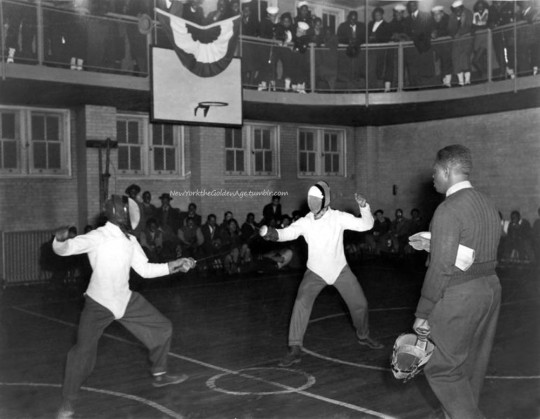#NYC Parks Dep't
Explore tagged Tumblr posts
Text

At the start of its “summer tour” of city playgrounds, the Department of Parks' Marionette Theatre performs “Jack and the Beanstalk” for an outdoor audience of children in Far Rockaway on July 12, 1952. This old favorite was dressed up by using modern equipment and techniques as the puppet theatre’s play for this season.
Photo: Ed Ford for the AP
#vintage New York#1950s#Ed Ford#marionettes#children's theater#July 12#NYC Parks Dep't#12 July#Jack & the Beanstalk#puppet show#marionette theater#vintage NYC
42 notes
·
View notes
Text

August 20, 1934, Inwood Hill Park.
Following the consolidation of the City's parks system under Commissioner Robert Moses in January 1934, the Parks Department announced plans to establish day camps for 2,500 children, with both an educational and recreational mission. The activities were jointly managed by Parks Department play leaders and staff from the Board of Education. The day camp depicted here was at the northern tip of Manhattan near the "old House of Mercy," and afforded views from the bluffs overlooking the Hudson. The programs consisted of games, nature and geology studies, arts and crafts, story telling, drama, and community singing among various activities, and children were provided free transportation and lunch.
Photo: NYC Parks Photo Archive
#vintage New York#1930s#NYC day camps#NYC Parks Dep't#vintage Inwood#Aug. 20#20 Aug.#Robert Moses#1930s New York#day camp
20 notes
·
View notes
Text

A peaceful scene in Brooklyn's Brower Park, September 28, 1941.
Photo: NYC Parks Dep't
#vintage New York#1940s#Brower Park#vintage Brooklyn#baby carriage#park#1940s New York#park scene#vintage NYC#Sept. 28#28 Sept.#peaceful
56 notes
·
View notes
Text

In Brooklyn in 1920, a 40–foot Christmas tree was erected in Prospect Park and decorated with 600 red, white, blue, green, and purple electric bulbs. A 50–foot community tree in 1926 surpassed the 1920 tree by ten feet and added 600 more colored electric lights.
Paid for by local civic organizations, the annual report noted that it “made a splendid appearance and could be seen from many streets and avenues approaching the park.” The annual report also noted Christmas trees set up at different points around the park that “when lighted during Christmas time, the illumination cast weird shadows through the trees and was much admired by people who visited the park to witness the display.” Three hundred school children from PS 9 sang Christmas carols around the tree “very much enjoyed by those present,” which included a version of “The Star Spangled Banner,” “O Come, All Ye Faithful,” and “Hark! The Herald Angels Sing,” capped off with a finale featuring “America, The Beautiful.” Christmas festivals continued into the 1930s at recreation facilities, as part of the regular Park programming, and children sang carols during the holiday season.
Photo: NYC Parks Dep't
#vintage New York#1920s#Christmas tree#Christmas#vintage Christmas#vintage NYC#vintage Brooklyn#public Christmas tree#Prospect Park#carolling#schoolchildren
148 notes
·
View notes
Text

Besides traditional pools, the city also had what were then called floating baths, like the one pictured above at West 96th Street on August 19, 1938. The water inside this pool was taken from the Hudson River.
Photo: NYC Parks Dep't via Rare Historical Photos
#vintage New York#1930s#floating baths#pools#pools with river water#Aug. 19#19 Aug.#vintage summer#1930s New York
53 notes
·
View notes
Text

At the opening ceremony of the Dr. Gertrude B. Kelly Playground on West 17th St., with an eager crowd of children, August 8, 1934.
Photo: Max Ulrich via the NYC Parks Dep't
#vintage New York#1930s#Max Ulrich#playground#opening day#vintage Chelsea NY#children#Dr. Gertrude B. Kelly#Aug. 8#8 Aug.#1930s New York#vintage summer
28 notes
·
View notes
Text

The wading pool, Carmansville Playground, July 1935. Carmansville was an old name for the West Side neighborhood extending from 140th Street, just north of City College, to 158th Street. The area is now known as Hamilton Heights (southern part) and Sugar Hill (northern part).
This new era of active recreation was thanks to the Departments of Parks harnessing the labor force of the Works Progress Administration, which employed millions of jobless people to carry out public works projects.
Photo: NYC Parks Dep't via the Daily Mail
#vintage New York#1930s#Carmansville#Hamilton Heights#Sugar Hill#public pool#kids swimming#wading pool#vintage summer#vintage NYC#WPA#water games
98 notes
·
View notes
Text

Kids waiting for the new pool at Thomas Jefferson Park to open on June 27, 1936 in East Harlem.
Photo: NYC Parks Dep't via Rare Historical Photos
#vintage New York#1930s#vintage NYC#pools#children#Thomas Jefferson Park#vintage Harlem#June 27#27 June#1930s swimsuits#1930s bathing suits
38 notes
·
View notes
Text

Kids playing ping-pong at the recently built athletic facility in Mount Morris (now Marcus Garvey) Park, April 26, 1943. This appears to be an elimination round in the New York Community Trust's Spring Sports Tournament (note the tourney poster on the wall), in which the ping-pong finals took place a few days later, on May 1. Over 20,000 boys and girls between the ages of 12 and 18 took part in the tournament, which included 13 sports and took place at numerous parks and recreation facilities citywide.
Photo: NYC Dep't of Parks & Recreation
#vintage New York#1940s#ping-pong#sports#athletic contest#games#April 26#26 April#Marcus Garvey Park#Mount Morris Park
39 notes
·
View notes
Text

Fencing contest in the Hansborough Recreation Center, Harlem, January 6, 1940. It was part of a full day of athletic competition at the center that also included gymnastics, boxing, basketball, and swimming races. The festivities were launched by a marching band.
The recreation center, originally known as the 134th Street Natatorium, opened in 1925, and is notable for its decorative architecture. The facility was named in honor of John Rozier Hansborough Jr. (1907-1981), a former Parks recreational employee from 1929 to 1975, and Harlem community leader. Hansborough also broke the color barrier as one of the first two African-Americans in the International Association of Approved Basketball Officials. In 1988, his widow, Audrey S. Hansborough, founded a conservancy in his memory that helps support the maintenance and management of Harlem's parks, playgrounds, and recreation centers.
Source: NYC Dep't of Parks & Recreation
#New York#NYC#New York City#1940s#fencing#Jan. 6#fencing competition#John Rozier Hansborough Jr.#January 6#Harlem#recreation center#vintage Harlem
41 notes
·
View notes